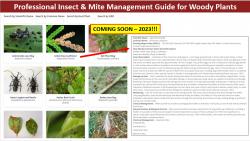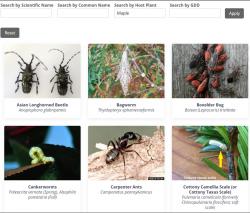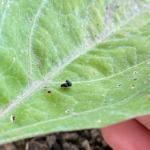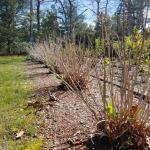A monthly e-newsletter from UMass Extension for landscapers, arborists, and other Green Industry professionals, including monthly tips for home gardeners.
To read individual sections of the message, click on the section headings below to expand the content.
To print this issue, either press CTRL/CMD + P or right click on the page and choose Print from the pop-up menu.
UMass Extension’s Professional Insect & Mite Management Guide for Woody Plants is About to Be Released!
 The long awaited, updated, and re-envisioned Professional Insect & Mite Management Guide for Woody Plants is coming soon! This guide is intended for use by professional land managers, including but not limited to: landscapers; arborists; urban and community foresters; tree wardens; local, state, and federal land managers; groundskeepers; and any landscape practitioner who is managing the health of trees and shrubs.
The long awaited, updated, and re-envisioned Professional Insect & Mite Management Guide for Woody Plants is coming soon! This guide is intended for use by professional land managers, including but not limited to: landscapers; arborists; urban and community foresters; tree wardens; local, state, and federal land managers; groundskeepers; and any landscape practitioner who is managing the health of trees and shrubs.
The insects listed in this guide are a compilation of pests of trees and shrubs that are frequently asked about, observed, or potentially historically reported to UMass Extension. A foundational list of species was included from the 2008 (print only) version of the Professional Management Guide for Insects, Diseases, and Weeds of Trees and Shrubs in New England (contributing entomology authors: Robert Childs and Craig Hollingsworth). This current version of the Professional Insect & Mite Management Guide for Woody Plants has been updated to focus solely on insect pests and their relatives. It includes updates for invasive (non-native) insects as well as native species that have more recently become a concern in Massachusetts and other areas of New England and New York. The host plants listed for these species are those that have been found in a brief review of recorded literature and do not necessarily represent records of these pests on those specific hosts in Massachusetts. This guide has also been updated to include information about growing degree days (if available), host plants, insect/pest descriptions, host plant damage, monitoring, cultural management, natural enemies and biological control, as well as chemical management options. It is also now searchable by pest scientific name, common name, host plant(s), and the current growing degree day measurement.
 Over 200 potential insect or mite pests of ornamental trees and shrubs are included in this freely available, online, and searchable Guide. And new insects and insect relatives will be added to this Guide as the information becomes available. While we hope users enjoy this soon-to-be-finished version of the Guide, it will be a living document where new insects and mites reported by professionals in Massachusetts can be continuously added, now and in the future. Enjoy, and thank you all for your patience while awaiting this giant project!
Over 200 potential insect or mite pests of ornamental trees and shrubs are included in this freely available, online, and searchable Guide. And new insects and insect relatives will be added to this Guide as the information becomes available. While we hope users enjoy this soon-to-be-finished version of the Guide, it will be a living document where new insects and mites reported by professionals in Massachusetts can be continuously added, now and in the future. Enjoy, and thank you all for your patience while awaiting this giant project!
Note: UMass Extension's Professional Management Guide for Diseases of Trees and Shrubs is already available online here.
Tawny Simisky, Extension Entomologist, UMass Extension Landscape, Nursery, & Urban Forestry Program
Trouble Maker of the Month
Flea Beetles
Flea beetles are tiny beetles (about 3mm long) that jump when startled as fleas do. Most species are dark in color, but some may also have bright spots or stripes. There are several species of flea beetle that feed on vegetable crops, but each species shows a marked preference for a particular host plant family; for instance, the crucifer flea beetle feeds only on plants in the Brassica family.
Flea beetle adults overwinter in crop debris or in wooded areas, moving into vegetable fields and gardens in spring to feed. Most species lay eggs in soil at the base of the host plant, and larvae feed on root hairs until they pupate and emerge as adults. There are typically one or two generations per season.
Flea beetle feeding creates numerous small holes in foliage, and plants may be weakened or stunted due to loss of photosynthetic capacity. In some cases, yield may be decreased and fruit undersized. Defoliation may also occur, and severely affected plants may die. Mature plants are better able to withstand and outgrow feeding damage, but seedlings and young plants are especially vulnerable to serious injury. Feeding damage is usually most severe in spring and early summer.
Management is especially important for the protection of seedlings and young plants. Protect crops with floating row covers. Control weeds. Some gardeners use trap crops to attract flea beetles away from desired crops; for example, a trap crop of radish seedlings may be used to lure beetles away from other brassicas. Trap crops should be removed once the desired crop is mature. Ensure good nutrition and plant health to maintain optimal growth. Products containing diatomaceous earth, kaolin clay, pyrethrin, and spinosad are approved for organic growers.
Angela Madeiras, UMass Extension Plant Pathologist
Q&A
Q. My bigleaf hydrangea aren’t performing well this year. What happened and what can I do?
A. Bigleaf hydrangea (Hydrangea macrophylla) and mountain hydrangea (H. serrata) around Massachusetts were damaged by an extreme low temperature event on February 4, 2023. This low temperature event resulted in widespread damage to woody stems and buds of bigleaf hydrangea, which have a maximum hardiness of 1°F to - 11°F, depending on cultivar. The hydrangea plants survived, but in many cases the stems were killed to or near ground level.
Ideally, the damaged stems should have been cut back in early June to healthy buds or near the ground to allow plenty of space for new vigorous stems to develop. Stems can still be removed now, but care should be taken not to damage newly developing shoots. In some situations, waiting until the shoots have become a little sturdier in late summer or possibly even the dormant season may be the best option.
The damage will result in far fewer flowers this year. Bigleaf hydrangea initiates flowers in the late summer/fall of the previous season and therefore are susceptible to being damaged during the winter. Some cultivars of bigleaf hydrangea are referred to as remontant, meaning capable of blooming on old and new wood. Cultivars in the Endless SummerTM series, Let’s DanceTM series, and Tuff StuffTM hydrangeas are capable of blooming on new wood as well as old wood. These cultivars will likely have more flowers than older cultivars that bloom solely on old wood.
Other hydrangeas, including smooth hydrangea (H. arborescens), oakleaf hydrangea (H. quercifolia), and panicle hydrangea (H. paniculata), were not impacted and should perform as usual. Bigleaf hydrangea was not the only plant to suffer damage this winter due to extreme cold or late frosts; other plants that were widely impacted include butterfly bush, rose, and azalea. Cleaning up damaged woody plants is an important sanitation task because damaged tissues can be sites for some pests and pathogens to attack. Prune out weak and damaged tissues during dry spells if possible.
For more information on challenges with Hydrangea macrophylla flowers please refer to this following UMass Extension fact sheet.
Russell Norton, Horticulturist, Cape Cod Cooperative Extension
Garden Clippings Tips of the Month
July is the month to . . . .
-
Deadhead spent flowers of perennial and annual plants. Removing faded or dead flowers from the plant can promote new growth, help keep plants looking attractive, and encourage more rebloom in some species. Flowers that go to seed consume large amounts of a plant’s energy, diverting it from vegetative growth. Regular deadheading directs energy into stronger growth and more flowers. Deadheading may not be absolutely necessary on some plants, but it greatly improves their appearance.
-
Keep weeding! Make sure to control weeds before they go to seed. If you catch weeds when they are still small, you can get decent control by using mechanical control methods such as pulling, hoeing, or cultivating. For difficult to control weeds such as yellow nutsedge, common blue violet and dandelion, you may need to use an herbicide. Make sure to select the right herbicide for the weed species present, and to read and follow the directions on the label.
-
Provide supplemental irrigation to newly planted trees and shrubs. If there is less than 1 inch of rainfall during a week, make sure to water newly planted trees and shrubs and trees planted within the last two years. Using a soaker hose or a slow trickle of water from a regular hose to the root area works best for trees and shrubs. Apply enough water to penetrate the soil to a depth of at least 10–14 inches once every two weeks.
-
Water vegetable and flower gardens as needed. To reduce loss due to evaporation, water gardens in the morning. Water the soil and avoid getting water on plant foliage to reduce fungal diseases. Water deeply and infrequently to encourage root growth.
-
Remove water sprouts from the canopy of fruit trees. Water sprouts are vigorous, upright shoots that develop on the trunk or large branches of a tree. Check trees regularly and remove new shoots as they emerge. If water sprouts are allowed to remain on the tree, they can ruin the tree's shape, shade other parts of the tree, and divert energy from the rest of the tree. For plants grafted onto the rootstock of another species during production, it may be the rootstock species that is sprouting and can result in undesired plant growth of a different species than what was planted. Water sprouts are unproductive and clutter up the canopy. Getting more sunlight and wind into the canopy will decrease humidity and the incidence of diseases, and the fruits will be brighter in color.
-
Watch for spider mites. Spider mites can become a problem during hot, dry weather on ornamental plants, vegetables, and fruit crops. Spider mites can be difficult to see until populations get large and plants start showing symptoms of their feeding. If you suspect you have spider mites, closely inspect the undersides of leaves using a magnifying lens. Watch for very small mites that can range in color from yellowish or greenish to brown to orange-red. Symptoms of mite damage include a speckled or mottled appearance on leaves and, as feeding continues, leaves may begin to yellow or bronze and eventually die. Severe infestations of spider mites can cause plants to become stunted, defoliated, and potentially die. Insecticidal soaps and horticultural oils are commonly used to manage spider mites. These pesticides have no residual activity and must come into contact with the mites to work, so good coverage is important for both the upper and lower sides of leaves when using them. Make sure to read and follow the directions on the label.
-
Watch for blossom end rot. Blossom end rot manifests as a black, sunken areas on the end of fruits. Blossom end rot is most often found on tomatoes but also may occur on peppers and summer squash. Blossom end rot starts as water-soaked areas that appear on the blossom end (bottom) of the fruit. The affected tissue desiccates, becoming brown and leathery. Secondary fungi and bacteria may cause the dead tissue to turn dark and rot. Blossom end rot can lead to premature ripening as well as inedible fruit. This condition is caused by a calcium deficiency in developing fruit induced by fluctuations in the plant’s water supply as a result of erratic watering. To reduce blossom end rot, water tomato plants on a weekly basis during dry weather to provide a consistent supply of moisture to the plants.
-
Water the lawn. Most turfgrasses require 1-1.5 inches of water per week. Unless local water restrictions are in place, irrigate slowly so that water can enter the soil surface and avoid surface runoff or puddling. Avoid excessive irrigation that causes soggy conditions which can intensify soil compaction.
-
Mow the lawn high. To reduce stress on turfgrasses, mow high and infrequently. Mow the lawn at a height range appropriate for the turf species and use (3 to 3.5 inches is a good target for residential lawns) to encourage shading of the soil surface, deeper rooting, and drought survival.
-
Order spring flowering bulbs for fall planting. July is a good time to order spring flowering bulbs like daffodils, Dutch iris, tulips, and hyacinths. Ordering early guarantees best selection and ensures that you get all bulbs shipped to you in time for planting in the fall. Make sure bulbs are firm when you receive them. Keep them cool (50-65°F) before planting and away from ripening fruit. The size and number of next year's flowers is directly related to the size of the bulb.
Geoffrey Njue, UMass Extension Sustainable Landscapes Specialist
Creating a Home Safe for Fireflies
Fireflies evoke a feeling of magic and wonder; elegant blobs of light dancing and blinking in the summer night.
Everything about fireflies hearkens back to a time long past. Imagine living on Earth 75-130 million years ago. Dinosaurs tromping and roaming. The air is hot and humid. There are no cars, no city lights, no porch lights, no stadium lights. Nothing. But it isn’t pitch black because the stars fill the sky. It will still be millions of years before humans create the first artificial light sources to change all of this. It was in these dark nights that the first ancestors of fireflies are thought to have evolved from Elateroid beetles. Yes, fireflies are beetles, not flies or bugs.
Why did flashing evolve? We think it mostly boils down to reproduction (Powell et al. 2022). In the same way that birds call to each other with song, fireflies communicate using their own love language in the form of light flashes. As far as we know, every species of firefly has its own flash pattern, a “morse code”-like series of blinks, glows, and flickers. If you can decode these patterns, you can figure out which species you’re looking at! There are an estimated 170 species of fireflies in North America. There could be several different species in your own backyard!
For those of us who grew up with fireflies as a regular occurrence, we can’t help but wonder: Where have they all gone? Like declines in other insects, there is no simple answer. Fireflies have a delicate life history that can span several years. Some species can spend as long as 2 years developing as larvae. During this time, larval fireflies and their prey (e.g. earthworms, snails, slugs) require clean and moist environments. They also depend on leaflitter around the yard. There is some uncertainty about if and what adults eat, but they have been observed around common milkweed (Asclepias syriaca) (Faust and Faust, 2014).
During the adult stage, many females perch in the dark on knee or waist-high vegetation while their male counterparts flash from the skies. Females only reveal their presence when males flash to meet their standards, effectively “swiping right.”
Heavy mowing (>50% of yard, every 2 weeks or more often), leaf litter removal, mosquito spraying with pyrethroids, and fertilizer use have been associated with decreased firefly abundance (Ridenhour, 2022). Landscape practices to help maintain firefly habitat include:
- Managing your landscape to include some “wild” vegetation: patches of tall grass, common milkweed, shrubs, brush, leaf litter.
- Minimizing the use of chemical treatments in and around the borders of your property if possible. This includes essential oil treatments. Although advertised as eco-friendly alternatives, they have been linked to decreases in insect taxa, including beetles (Elias et al. 2013).
- Avoiding tick control applications from July-October. The application of any sprays to control ticks from July-October is not recommended as a cost-effective management strategy. Nymphal and adult deer ticks (Ixodes scapularis) are the life stages responsible for transmission of most diseases. Prime season for nymphs peaks in May and declines onward. Adult deer ticks are already difficult to find. These life stages will become increasingly more rare as we head into the summer months.
- Minimizing artificial light at night. Artificial light generated from flood lights, windows, porch lights, and other sources impact the ability for fireflies to communicate with one another.
Artificial light pollution is causing our nights to grow brighter by 9.6% each year (Kyba et al. 2023). Kyba estimates that “children born today in a light-polluted area who can see about 250 stars would see skyglow quadruple by their 18th birthday – leaving only 100 stars to wish on.”
So, this summer, enjoy your cookouts, pool time, and beach days. But, before you close your eyes, please remember to turn out the lights.
Citations:
- Elias, S. P., Lubelczyk, C. B., Rand, P. W., Staples, J. K., St. Amand, T. W., Stubbs, C. S., ... & Smith Jr, R. P. (2013). Effect of a botanical acaricide on Ixodes scapularis (Acari: Ixodidae) and nontarget arthropods. Journal of medical entomology, 50(1), 126-136.
- Faust, L., & Faust, H. (2014). The occurrence and behaviors of North American fireflies (Coleoptera: Lampyridae) on milkweed, Asclepias syriaca L. The Coleopterists Bulletin, 68(2), 283-291.
- Powell, G. S., Saxton, N. A., Pacheco, Y. M., Stanger-Hall, K. F., Martin, G. J., Kusy, D., ... & Bybee, S. M. (2022). Beetle bioluminescence outshines extant aerial predators. Proceedings of the Royal Society B, 289(1979), 20220821.
- Kyba, C. C., Altıntaş, Y. Ö., Walker, C. E., & Newhouse, M. (2023). Citizen scientists report global rapid reductions in the visibility of stars from 2011 to 2022. Science, 379(6629), 265-268.
- Ridenhour, K. (2022). Atlanta Firefly Project: Using Community Science to Explore the Effects of Land Management on the Local Abundance of the Big Dipper Firefly (Photinus pyralis) in City Parks and Residential Yards (Doctoral dissertation, University of Georgia).
Blake Dinius, Plymouth County (MA) Entomologist
A Note for Growers on the May 18, 2023 Freeze Event
Massachusetts experienced a widespread, late-season freeze on the morning of May 18 and damage from this continues to be observed. While there are broad concerns about damage to agricultural crops that have made headlines, some producers of ornamental crops were adversely affected as well. Growers that have related crop losses that exceed 30% may be eligible for emergency assistance. Note that in order to qualify, an operation must have 50% or more of production "on farm", and finished crops purchased for resale are not eligible. Contact the Farm Service Agency office in your county: https://offices.sc.egov.usda.gov/locator/app?state=ma&agency=fsa
Upcoming Events
For details and registration options for these upcoming events, go to the UMass Extension Landscape, Nursery, and Urban Forestry Program Upcoming Events Page.
- 7/19/23 - UMass Turf Research Field Day, South Deerfield MA, 9:00 am - 1:00 pm.
2 pesticide contact hours for categories 37, Dealer, and Applicator's (Core) License; 1 MCLP, 1 MCH, and 0.25 CGCS education points and credits available.
Pesticide Exam Preparation and Recertification Courses
These workshops are held virtually. Contact Natalia Clifton at nclifton@umass.edu or go to https://www.umass.edu/pested for more info.
Additional Resources
For detailed reports on growing conditions and pest activity – Check out the Landscape Message
For professional turf managers - Check out our Turf Management Updates
For commercial growers of greenhouse crops and flowers - Check out the New England Greenhouse Update website
For home gardeners and garden retailers - Check out our home lawn and garden resources
TickTalk webinars - To view recordings of past webinars in this series, go to: https://ag.umass.edu/landscape/education-events/ticktalk-with-tickreport-webinars
Diagnostic Services
Landscape and Turf Problem Diagnostics - The UMass Plant Diagnostic Lab is accepting plant disease, insect pest and invasive plant/weed samples. By mail is preferred, but clients who would like to hand-deliver samples may do so by leaving them in the bin marked "Diagnostic Lab Samples" near the back door of French Hall. The lab serves commercial landscape contractors, turf managers, arborists, nurseries and other green industry professionals. It provides woody plant and turf disease analysis, woody plant and turf insect identification, turfgrass identification, weed identification, and offers a report of pest management strategies that are research based, economically sound and environmentally appropriate for the situation. Accurate diagnosis for a turf or landscape problem can often eliminate or reduce the need for pesticide use. See our website for instructions on sample submission and for a sample submission form at http://ag.umass.edu/diagnostics.
Soil and Plant Nutrient Testing - The lab is accepting orders for Routine Soil Analysis (including optional Organic Matter, Soluble Salts, and Nitrate testing), Particle Size Analysis, Pre-Sidedress Nitrate (PSNT), Total Sorbed Metals, and Soilless Media (no other types of soil analyses available at this time). Testing services are available to all. The lab provides test results and recommendations that lead to the wise and economical use of soils and soil amendments. For updates and order forms, visit the UMass Soil and Plant Nutrient Testing Laboratory web site.
Tick Testing - The UMass Center for Agriculture, Food, and the Environment provides a list of potential tick identification and testing options at: https://ag.umass.edu/resources/tick-testing-resources.





